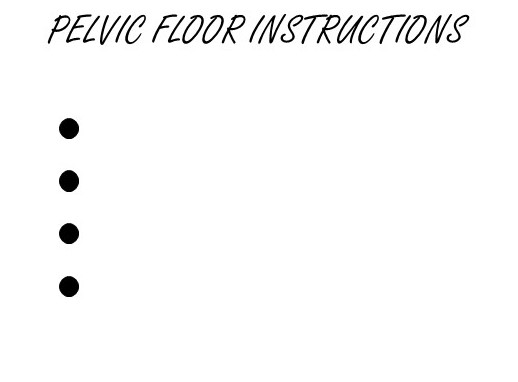
I’ve been given a sheet of pelvic floor exercise instructions, why should I see a men’s health physio?
Many men are provided with sheets of paper from their urologist, doctor or nurse containing instructions as to how to perform pelvic floor exercises. Others will find instructions for pelvic floor exercises online. That being the case, why then should you consult a men’s health physiotherapist to be taught pelvic floor exercises and prescribed a pelvic floor training program?
Trying to learn and perform pelvic floor exercises from a sheet of paper or instructions on the internet (or elsewhere) is fraught with danger. Pelvic floor exercises performed incorrectly, can actually result in a negative effect and even a worsening of your symptoms (depending on what they are). The reasons for this are outlined below.
For the vast majority of healthy men, with no urinary voiding or sexual dysfunction, their pelvic floor muscles just work automatically. That means that until men have an issue in this regard they will never have had to think about using their pelvic floor muscles. Many men would be also be unaware that they even have pelvic floor muscles or what they do. How then do you get someone to use muscles that they have never consciously used before? This is even harder if these muscles are not working as they should!
Making things tougher again is that the male pelvic floor muscles cannot be seen. Nor does anything move on the exterior of the body to know that you have contracted your pelvic floor. So, there is nothing that you can see to know that you are contracting your muscles properly. It is not like your biceps muscle in your arm, where when you pick up a weight and bend your elbow, you may see your biceps muscle bulge. Also, in this example we know that if your elbow bends, that your biceps muscle must be contracting effectively.
What about what it feels like to contract your pelvic floor muscles? The trouble with this is that there is a huge variety in what men report as feeling even when they correctly contract their pelvic floor muscles. Many men correctly contracting their pelvic floor, report not feeling like anything is particularly happening in their pelvic or genital region. Others only report a certain sensation in this region once they have become extremely familiar with the muscle contractions. Complicating things further is that of those men who do feel something happening in their pelvic or genital region, the description of what they feel is happening varies enormously, thus making what it feels like to contract your pelvic floor correctly, not particularly helpful.
Another aspect that needs to be considered is that the exercises prescribed on the sheet of paper (or other instructions) may be too advanced or not advance enough, either in terms of quantity or difficulty. As with any muscle in the body, things can be weak and as a result you may only be able to perform a certain number of contractions properly. How would you know if you could properly do 5 pelvic floor contractions, but the instructions tell you to do 15? The trouble is you can’t, unless you are very familiar with pelvic floor contractions. Conversely, you may be very good at completing what is in the instructions given to you and as such you could benefit from having your program of exercises progressed.
So, what actually can go wrong when attempting to contract your pelvic floor muscles, just using written or verbal instructions provided to you?
- The first thing that can occur is that nothing happens. Given that you are likely to be unfamiliar with contracting your pelvic floor muscles and that you have never had to consciously contract these muscles, it is highly likely that even with your best efforts to follow the instructions, that nothing will actually happen. How would you even know?
- On the other end of the spectrum, even if you are able to contract your pelvic floor muscles well, it is possible to contract them too heavily. The pelvic floor muscles generally work quite gentle when everything is functioning well. It seems to be an inherent male trait, that when given instructions to do anything, we try to do as hard as possible. As a result, it is possible to contract your pelvic floor muscles too strongly. How would you even know?
- Another common fault for many men is that they contract their abdominal muscles strongly simultaneously as they attempt to contract their pelvic floor muscles (whether successfully or not). The problem with this is that it leads to an increase in what is known as intra-abdominal pressure. This basically results in a squeezing of the bladder, which can actually make any continence issues worse. How would you even know?
- A final common fault to outline is that when attempting to contract pelvic floor muscles, many men hold their breath. This too can lead to an increase in intra-abdominal pressure. It’s also not how things work in the real world. You need to have the capacity to have your pelvic floor muscles contract independently of your breathing. This is something that you could probably keep an eye out for yourself to see if you were doing this.
So, what does a men’s health physiotherapist do that differs from a set of written or verbal instructions?
- Firstly, physiotherapists with experience in dealing with male pelvic floor training, will use real-time ultrasound to actually see whether the pelvic floor muscles are contracting as desired. This can be great for men to see, especially if they cannot feel anything happening. It also provides some reassurance to many men that something is actually happening internally, as they can’t see or feel anything happening. This also allows the physiotherapist to try a number of different prompts or techniques to get the best contraction from you (as seen on ultrasound) and hence give personalised instructions as to what works best for you.
- Using ultrasound can also allow a men’s health physiotherapist to assess to quality of your pelvic contractions to determine whether there are certain muscles within the pelvic floor (it is not just one muscle, but a group of lots of muscles!) not working as well as desired and to then try to train specific muscles within the pelvic floor with specific instructions or techniques. In a similar way, the endurance of pelvic floor muscle contractions can be assessed in terms of length of time able to maintain a contraction or ability to perform repeated contractions. The result of this is that a more specific program of pelvic floor exercises can be prescribed.
- An experienced men’s health physiotherapist will also be able to feel and see many subtle things in the abdominal and pelvic region occurring, as you attempt to contract your pelvic floor muscles. This too will guide how things can be adjusted to be specific to your needs.
- Finally, the symptoms (if any) that you are getting will likely impact on what you need to be doing with your pelvic floor contractions. Some men will need to perform sustained pelvic floor contractions, others quicker repeated contractions, others contractions in various positions/postures, others contractions with various body movements and many others. It is not a one size fits all approach and as such to get the best results, you ought to consult with someone who can guide you accordingly.



